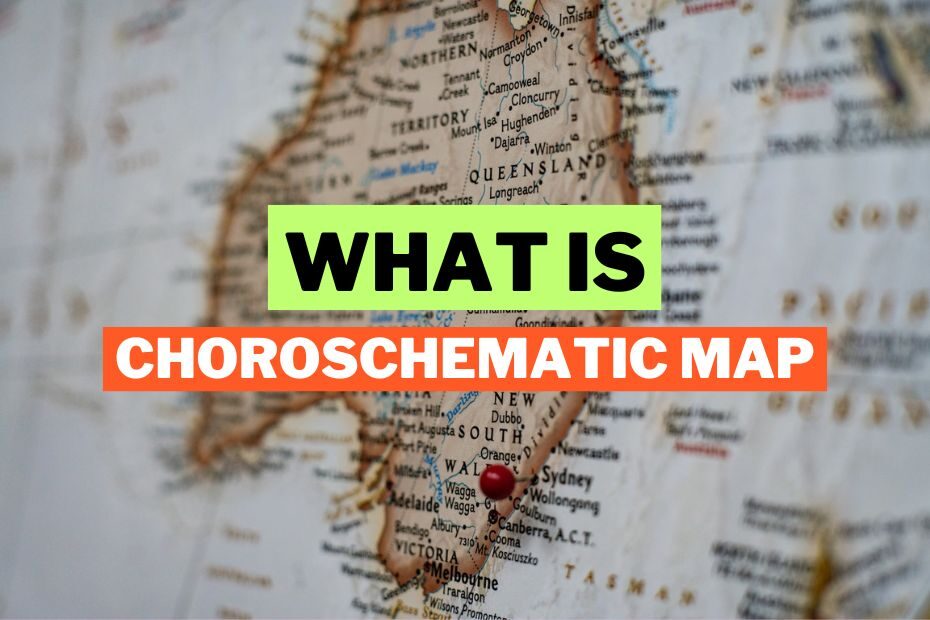If you are someone who enjoys reading about maps or has an interest in cartography, you might have come across the term choroschematic map. But what exactly is a choroschematic map? In this article, we will take a closer look at the definition, purpose, and examples of choroschematic maps.
A Choroschematic map is a categorical map in which regions are shaded or patterned in proportion to the measurement of interest.
These data visualization methods are used for showing how some quantity varies geographically, such as population density or per-capita income. It is often used to show differences between countries with respect to various measurements like average income.
What Is Choroschematic Map?
A choroschematic map is a type of thematic map that uses abstract symbols and shapes to represent spatial data. Unlike other types of maps, such as topographic maps, choroschematic maps do not aim to accurately represent the physical features of a particular area. Instead, they use simplified shapes and patterns to convey information about a specific topic or theme.
This type of map can be used for showing the location of schools, hospitals, and police stations. It can also be useful for presenting the population density, soil and vegetation of an area. Various Cartographic symbols are used like: circles, dots, triangles etc.
The word “choroschematic” is derived from the Greek words “choros,” which means space or place, and “schematic,” which refers to a simplified or abstract representation. Therefore, a choroschematic map is essentially a simplified representation of spatial data.
Choroschematic map is a powerful device for visualizing spatial patterns over a geographic area and can help people understand complicated issues such as climate change or poverty rates.
Purpose of Choroschematic Maps
The purpose of choroschematic maps is to communicate information about spatial data in a clear and concise manner. These maps are commonly used to visualize statistical data, such as population density, income levels, or crime rates.
Choroschematic maps are particularly useful for highlighting patterns and trends in data. By using abstract symbols and shapes, these maps can effectively convey complex information in a way that is easy to understand.
Benefits of Using Choroschematic Maps
There are several benefits to using choroschematic maps, including:
- Highlighting patterns and relationships: Choroschematic maps can be an effective way to highlight patterns and relationships in data that might not be immediately apparent in a table or chart.
- Easy to understand: Choroschematic maps can be easier to understand than other types of maps, as they use patterns or symbols to represent data rather than complex geographic features.
- Can be used to represent a wide range of data types: Choroschematic maps can be used to represent a wide range of data types, including demographic information, voting patterns, and economic data.
- Can be used to compare data across different regions: Choroschematic maps can be used to compare data across different regions, making it easier to identify trends and patterns.
Drawbacks of Using Choroschematic Maps
There are also some drawbacks to using choroschematic maps, including:
- Can be misleading: Choroschematic maps can be misleading if the patterns or symbols used to represent data are not chosen carefully.
- Can oversimplify data: Choroschematic maps can oversimplify data, making it difficult to see the nuances of the data being presented.
- Can be difficult to create: Creating an effective choroschematic map can be difficult, as it requires careful selection of patterns or symbols that accurately represent the data being presented.
Examples of Choroschematic Maps
There are many different types of choroschematic maps, each of which is designed to convey a particular type of spatial data. Here are a few examples:
1. Dot Maps
A dot map is a type of choroschematic map that uses dots to represent individual data points. Each dot on the map represents a specific number of occurrences or incidents, such as the number of crimes in a particular area.
2. Choropleth Maps
A choropleth map is a type of choroschematic map that uses different colors or shades to represent different levels of a particular variable, such as population density or income levels. These maps are commonly used to show patterns in data across different regions or areas.
3. Isarithmic Maps
An isarithmic map is a type of choroschematic map that uses lines to represent changes in a particular variable across a geographic area. For example, an isarithmic map might use lines to represent changes in elevation or temperature across a particular region.
Conclusion
In conclusion, a choroschematic map is a type of thematic map that uses abstract symbols and shapes to represent spatial data. These maps are designed to convey information about a specific topic or theme in a clear and concise manner, making them an effective tool for visualizing complex data. Whether you are a cartographer or simply someone with an interest in maps, understanding the purpose and examples of choroschematic maps can provide valuable insights into the world of spatial data visualization.
FAQs
What is the difference between a choroschematic map and a topographic map?
A choroschematic map uses abstract symbols and shapes to represent spatial data, while a topographic map aims to accurately represent the physical features of a particular area.
What are some common uses of choroschematic maps?
Choroschematic maps are commonly used to visualize statistical data, such as population density, income levels, or crime rates.
Can choroschematic maps be used to represent any type of spatial data?
Yes, choroschematic maps can be used to represent any type of spatial data, as long as it can be effectively communicated using abstract symbols and shapes.
